de Havilland Dragon Rapide
| DH.89 Dragon Rapide/Dominie | |
|---|---|
 | |
| Role | Short-haul airliner |
| Manufacturer | de Havilland |
| First flight | 17 April 1934 |
| Primary user | Royal Air Force |
| Number built | 727[1] |
The de Havilland DH.89 Dragon Rapide was a 1930s short-haul biplane airliner developed and produced by British aircraft company de Havilland. Capable of accommodating 6–8 passengers, it proved an economical and durable craft, despite its relatively primitive plywood construction.
Developed during the early 1930s, the Dragon Rapide was essentially a smaller, twin-engined version of the four-engined DH.86 Express, and shared a number of common features, such as its tapered wings, streamlined fairings and Gipsy Six engines. First named the "Dragon Six", the type was marketed as "Dragon Rapide" and later simply known as the "Rapide". Upon its introduction in summer 1934, it proved to be a popular aircraft with airlines and private civil operators alike, attaining considerable foreign sales in addition to its domestic use.
Upon the outbreak of the World War II, many of the civil Rapides were impressed into service with the Royal Air Force (RAF) and Royal Navy. Referred to in military service by the name de Havilland Dominie, the type was employed for radio and navigation training, passenger transport and communications missions; hundreds of additional Dominies were also constructed during the war. Other Rapides continued to be operated by British airlines throughout the war under the auspices of the Associated Airways Joint Committee (AAJC). Postwar, many military aircraft were returned to civilian service. Shortly after the end of the Second World War, de Havilland introduced a Dragon Rapide replacement, the de Havilland Dove.
Design and development
Origins
During summer 1933, the de Havilland aircraft company commenced work upon an aircraft to meet an Australian requirement, producing a four-engined faster passenger aircraft capable of seating ten passengers, the DH.86 Dragon Express.[2] An important feature of the DH.86 was the newly developed and powerful Gipsy Six engine, a six-cylinder variant of the four cylinder Gipsy Major engine. The DH.86 would serve as the a key starting point for the later DH.89.[2]
During late 1933, a team at de Havilland, led by aircraft designer Arthur Ernest Hagg, began working on a new design, intended to be a faster and more comfortable successor to the earlier DH.84 Dragon. The new aircraft was, in effect, a twin-engined, scaled-down version of the four-engined DH.86 Express.[2] It shared many common features with the earlier DH.86 Express, including its tapered wings, streamlined fairings and fuselage, as well as the same Gipsy Six engines.[2] However, the DH.89 demonstrated none of the operational vices of the Express.
On 17 April 1934, the prototype conducted its maiden flight at Hatfield Aerodrome, Hertfordshire.[2] Flown by senior de Havilland test pilot H.S. Broad, it was powered by a pair of 200 hp Gypsy Six engines. Even prior to the prototype's first flight, plans to proceed with serial production of DH.89 had already received the go-ahead from management.[2] During May 1934, airworthiness trials commenced at RAF Martlesham Heath using the prototype; during one such flight, upon attaining a speed of roughly 175 MPH, the tip of the aircraft's nose buckled. In response to this event, a maximum permissible speed of 160 MPH was implemented for all DH89.[2] Upon the conclusion of trials, the prototype was sold.[2]
By November 1934, series production of the Rapide had reached full swing.[3] Originally referred to as the "Dragon Six", the aircraft was first marketed as the "Dragon Rapide", although the type later came to be popularly referred to as simply the "Rapide".[2] Prior to the outbreak of the Second World War, 205 aircraft were manufactured for airlines and other private owners all around the world. The Rapide is perhaps the most successful British-built short-haul commercial passenger aircraft to be produced during the 1930s.
Further development
In response to the issuing of Specification G.18/35 by the British Air Ministry, de Havilland decided to design and produce a single prototype of a modified Rapide for undertaking coastal reconnaissance.[3] Trials using the prototype, K4772, were performed between April and June 1935 at RAF Martlesham Heath and RAF Gosport. However, it ultimately lost out to its rival, the Avro Anson.[3] K4772 was later used by the Royal Aircraft Establishment (RAE) in automatic landing trials before being broken down for spares. Work on a militarised version of the Rapide was not wasted as multiple sales were soon completed with other military customers, the first of which being to the Spanish government in December 1935.[3]
Sensing demand for the type, de Havilland continued to modify the Rapide's design following its entry to service, creating both refinements and entirely new derivatives as a result. Aiming to produce a faster version of the Rapide, a smaller, lighter and externally cleaner version, designated as the DH.90 Dragonfly, emerged; first flying in August 1935, the DH.90 failed to achieve a similar rate of sales to the Rapide and production was terminated in 1938 after 67 aircraft had been completed.[4] In November 1935, the 60th airframe to be produced, G-ADWZ, was modified and used by de Havilland as a trials aircraft. Fitted with elongated rear windows, cabin heating, thickened wing tips, and a strengthened airframe to allow for an elevated gross weight of 5,500 lb, G-ADWZ later participated in trials at Martlesham Heath, after which the higher gross weight was cleared for service.[4]
In response to the announcement of an air race between Britain and Johannesburg, South Africa, de Havilland's design team produced a specialised variant of the Rapid, designated as the DH.92 Dolphin.[4] This one-off derivative featured a retractable undercarriage, an expanded wingspan of 53 ft 7 in, a modified nose section, and an increased all-up weight of 6,600 lb; however, flight tests in August 1936 revealed there to be no performance improvement over the standard Rapide, leading to the sole Dolphin being scrapped months later.[5]
In November 1936, in response to suggestions that the addition of flaps would aid in landing, a single Rapide was modified in order to explore their functionality.[6] Based on this performance, in February 1937, de Havilland announced that flaps would be fitted to all production aircraft from that year onwards, while other improvements such as a downwards-facing recognition light and metal propellers could be fitted as options. From 1937, to signify the fitting of improved trailing edge flaps, aircraft thus equipped were accordingly re-designated as DH.89A; earlier-built Rapides were commonly retrofitted to this standard during their service life as well.[6]
Operational history
Prewar operations
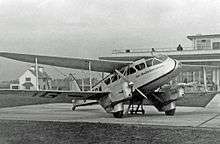
During July 1934, the first production Rapide, G-ACPM, performed the type's public debut at Hatfield with its entry into the 1934 King's Cup Race.[2] While having achieved an average speed of 158 MPH, G-ACPM had to be withdrawn from the race during Heat 9 of Round 2 when the wing sustained damage caused by hail while flying over Waddington, Lincolnshire. Another purpose-built Rapide, ZK'-ACO, was entered into the 1934 MacRobertson Air Race; fitted with three additional fuel tanks within the fuselage to extend the aircraft's range to 1,000 miles, the aircraft, flown by Squadron Leader J.D. Hewett and Mr C.E. Kay, took sixth place in the handicap race and fifth place in the speed race.[7]
In the summer of 1934, the type entered service with UK-based airlines, with Hillman Airways Ltd being first to take delivery in July. The Anglo-Persian Oil Company was another early company to purchase the Rapide; used for quick communications purposes between individual oil fields spread out over vast distances, the aircraft quickly became popular in the oil industry, with the Iraq Petroleum Company and the Asiatic Petroleum Company also procuring their own Rapides.[3]
From August 1934, Railway Air Services (RAS) operated a fleet of Dragon Rapides on routes linking London, the north of England and on to Northern Ireland and Scotland. The RAS DH.89s were named after places on the network, for example "Star of Lancashire".[8] Isle of Man Air Services operated a fleet of Rapides on scheduled services from Ronaldsway Airport near Castletown to airports in north-west England including Blackpool, Liverpool and Manchester. Some of its aircraft had been transferred to it after operation by Railway Air Services.
During late 1935, the first of an initial batch of 16 Rapides were shipped to the manufacturer's Canadian branch, de Havilland Canada, for modification and re-sale purposes.[3] Canadian aircraft received various changes, including an extended dorsal fin and a modified undercarriage arrangement, allowing for either wheels, skis, or floats to be interchangeably installed, dependent upon usage and weather conditions.[3] The sole Canadian prototype, CF-AEO, was sold onto Quebec Airways in June 1935. Further Rapides were delivered to other customers in Canada, such as Canadian Airways, who used it on their West Coast and maritime routes.[9]
On 30 January 1942, the majority of major Canadian operators were amalgamated into Canadian Pacific Air Lines, who continued to use the type.[4] Further Canadian sales of the Rapide would occur both during and after the end of the Second World War.
During 1938, British operator Airwork Limited placed an initial order for nine Rapides to serve as navigation trainers.[6] The order had been motivated by policy changes within the British Air Ministry, which sought to expand this capability. Repeat orders were placed by Airwork in the lead up to the Second World War, upon which point the firm's fleet of Rapides were all taken on by the Royal Air Force (RAF).[6]
Edward, Prince of Wales (later Edward VIII), owned a single Dragon Rapide (G-ADDD), which he frequently used for carrying out his royal duties. He flew this aircraft to London on his accession as king in 1936, making him the first British monarch to fly.[10]
One famous incident involving the Rapide occurred during July 1936 when a pair of British SIS agents, Cecil Bebb and Major Hugh Pollard, flew Francisco Franco in Rapide G-ACYR from the Canary Islands to Spanish Morocco, at the start of the military rebellion which began the Spanish Civil War.[11] The aircraft involved has since been placed on public display in the Museo del Aire, Madrid, Spain.
Second World War
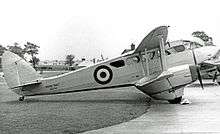
At the start of Second World War on 3 September 1939, all British civil transport aircraft were requisitioned by the Ministry of Aircraft Production. A number of Dragon Rapides were used to provide internal flights under the control of National Air Communications (NAC).[6] Perhaps one of the most significant early uses of the Rapide during the war occurred during the crucial weeks of May–June 1940, in which the Battle of France occurred; Rapides of No. 24 Squadron acted as aerial couriers between Britain and France; out of 24 aircraft, 10 Rapides were lost during this intense period of fighting.[6]
Following the closure of the NAC network, Dragon Rapides continued to fly for British airlines during the war as part of the Associated Airways Joint Committee (AAJC). Upon the outbreak of war, all civil services had been halted; however, some routes were progressively returned to operation as and when they were deemed of value to the war effort or found to be in the national interest.[12] The AAJC co-ordinated the majority of UK's wartime scheduled services, which were entirely operated on over-water routes.[13]
Other Dragon Rapides were impressed into service with the British armed forces as communications aircraft and training aircraft; Australian Rapides were also impressed by the Royal Australian Air Force (RAAF).[12]
Furthermore, while the final production Rapide was completed in November 1941, de Havilland instead produced the military-orientated Dominie variant exclusively.[13] Over 500 additional Dominies were manufactured for military use, powered by improved Gipsy Queen engines; by the end of production in July 1946, a total of 727 aircraft (both Rapides and Dominies combined) had been manufactured.[14] During the war, Dominie production was performed by de Havilland and Brush Coachworks Ltd, the latter being responsible for the greater proportion of the work. The Dominies were mainly used by the Royal Air Force (RAF) and Royal Navy for radio and navigation training. Other duties they were used for included passenger and communications missions.[13]
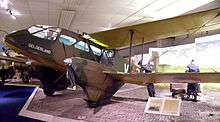
Throughout the course of the war, civilian Rapides were progressively replaced by Dominies as the type became available in greater quantities.[13] Rapides were either dispatched to perform passenger operations or occasionally converted for other purposes, such as Air Ambulances; by the end of the conflict, only a total of nine impressed Rapides were restored to their civilian registrations; however, these were joined by many Dominies which had been deemed to be surplus to requirements.[13]
Postwar operations
_AN0230937.jpg)
Postwar, the Dominie continued to be used for some time by Royal Naval air station flights as communications aircraft.[15] By 1960, the Royal Navy still had a fleet of 14 Dominies, although under normal circumstances only three would be actively used at any one point in time, while the others were stored at RAF Lossiemouth, Moray, Scotland. The last of the Royal Navy's Dominies had been phased out of service during 1963; thirteen aircraft were subsequently sold on via public tender, a number of which having been converted to civil Rapide configurations.[15]
Many ex-RAF survivors had quickly entered commercial service after the end of the conflict; according to aviation author Peter W. Moss, a typical Dominie-to-Rapide conversion performed by de Havilland involved the repainting of the exterior (replacing the wartime camouflage scheme) and the installation of sound proofing, upholstered seats and a new décor within the cabin area.[16] Additionally, various third party companies offered and performed their own conversion schemes, including Field Aircraft Services, Airwork Limited, Air Enterprises, W.A. Rollason Limited and the Lancashire Aircraft Corporation (LAC).[17] By 1958, 81 examples were recorded as still flying on the British register.
In the Netherlands, airline KLM, keen to restart operations, set about procuring a handful of Rapides even prior to the end of the war, commencing the first of its re-launched services during September 1945.[17] Various British airlines also became prolific users of the type; British European Airways (BEA), formed on 1 January 1946, took order 39 Rapides during February 1947. BEA used many across its fledgling network, later focusing upon services within the Scottish, Scilly, and Channel Islands while gradually selling on displaced and excess aircraft via Airwork.[17] Small independent British airlines that chose to resist pressure from the British government to merge into BEA also commonly operated the Rapide.[17]
In order to better distinguish between the different standards of Rapides available in the post-war environment, de Havilland established a basic mark number system.[17] Mk 1 aircraft were those constructed pre-war, while Mk 2 and Mk 3 Rapides were ex-military conversions to a six-passenger cabin and eight-passenger cabin respectively. Those Rapides that were re-engined with a pair of de Havilland Gipsy Queen engines, giving the aircraft an increased all-up weight to 6,000 lb along with improved climb, cruise speed and single engine performance, were referred to as Mk 4s.[17]
By 1966, use of the Rapide had gone into decline and several formerly large operators had phased out the type completely.[18] Due to the declining stocks of spare components available, individual Rapides were commonly being broken up in order to scavenge parts to maintain other active aircraft. Regardless, demand for such an aircraft was still relatively strong at this time, according to Moss.[15]
The DH.89 proved an economical and durable aircraft, despite its relatively primitive plywood construction and many were still flying in the early 2000s. Several Dragon Rapides are operational in the UK, while multiple operators, including Classic Wings and Plane Heritage, offer pleasure flights in them to the general public. Shortly after the end of the Second World War, de Havilland introduced a Dragon Rapide replacement, the de Havilland Dove.
Variants

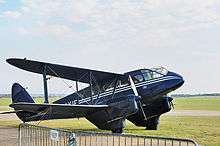
- D.H.89
- Twin-engined light transport biplane. First production version.
- D.H.89A
- Improved version, fitted with a landing light in the nose, modified wing tips and cabin heating.
- D.H.89A Series 4
- D.H.89A aircraft converted to two de Havilland Gipsy Queen 2 piston engines, fitted with constant speed propellers.[19][20]
- D.H.89A Mk 5
- One D.H.89A aircraft, powered by two de Havilland Gipsy Queen 3 piston engines, fitted with variable-pitch propellers.
- D.H.89A Mk 6
- One D.H.89A aircraft fitted with Fairey X5 fixed-pitch propellers.
- D.H.89M
- Military transport version. Exported to Lithuania and Spain.
- D.H.89B Dominie Mk I
- Radio and navigation training version.
- D.H.89B Dominie Mk II
- Communications and transport version.
Operators
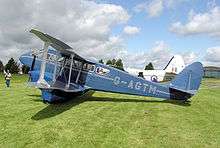
Civil
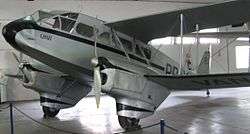
- Canadian Pacific
- Quebec Airways
- Misr Airlines
- Aero Oy operated two aircraft.
- Iranian State Airlines
- Aer Lingus
- Aer Turas operated one aircraft.
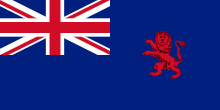
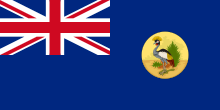
.svg.png)

- Valsts Gaisa satiksme
- Air Travel (NZ) Ltd
- Mount Cook Airline
- National Airways Corporation
- Cook Strait Airways Ltd
- Palestine Airways (British Mandate of Palestine)
- Aviron
- Aerocarga Asociados ACA
- Comair (South Africa) operated 2 aircraft.
- Air Charter Limited
- Air Atlantique Classic Flight now the Classic Air Force
- Airviews Ltd
- Air Enterprises
- British Continental Airways
- British European Airways
- British Westpoint
- Classic Wings
- Crilly Airways Ltd
- Hillmans Airways
- Highland Airways
- Isle of Man Air Services
- Jersey Airways
- Lancashire Aircraft Corporation
- Mayflower Air Services
- Melba Airways
- Morton Air Services
- Northwest Airlines (UK)
- Olley Air Services
- Railway Air Services
- Scillonia Airways
- Scottish Airways
- Sivewright Airways
- Starways
- Trans European Aviation
- Westward Airways (Lands End)
Military operators
- Belgian Air Force (Seven operated from 1946)
- Luftwaffe operated captured aircraft.
- Lithuanian Air Force operated two D.H.89M aircraft.
- Royal Netherlands Air Force – four D.H.89B Mark II (transports)
- No. 334 Squadron RNLAF (1944–1956)
- Southern Rhodesian Air Force – Four aircraft.
- Spanish Republican Air Force operated three D.H.89M requisitioned from LAPE
- Royal Yugoslav Air Force – One aircraft impressed into military service in 1940.
Accidents and incidents
- 2 October 1934, G-ACPM of Hillman's Airways crashed into the sea off Folkestone, Kent causing the death of the pilot and the six passengers.[22]
- 30 December 1936, G-AEGS of the Iraqi Petroleum Petrol Transport Company overturned in a forced landing in Palestine, two killed.[22][23]
- 3 July 1938, G-AEBX Star of Scotia of Railway Air Services crashed at Sydenham, Northern Ireland, two killed.[22][23]
- 20 June 1939, G-AERE operated by British American Air Services crashed in County Durham, England.[24] John Crouch who was the king's jockey, the pilot and the wireless operator were all killed.[25]
- 27 May 1941, R5929 a Dominie of the Royal Air Force near Devizes, Wiltshire, England, seven killed.[22]
- 7 July 1941, R9563 a Dominie of the Royal Navy crashed in bad weather three miles North of Stonehaven, Aberdeenshire, Scotland, six killed.[22]
- 14 February 1942, R5927 a Dominie of the Royal Air Force hit a balloon cable and crashed near Colnbrook, Wiltshire, England, six killed.[22]
- 29 May 1942, VH-UXZ of Australian National Airways crashed near Flinders Island, Bass Strait, Australia following engine failure, four killed.[22]
- 6 February 1945, SU-ABP of Misr Airwork crashed in Egypt, seven killed.[22]
- 1 April 1946, G-AERZ of Railway Air Services crashed in County Down, Northern Ireland,[26] six killed.[22]
- 30 August 1946, X7394 a Dominie of the Royal Navy crashed at Scafell Pike, Cumberland, England in bad weather during an ambulance flight, five killed.[22]
- 15 April 1947, G-AHKR of British European Airways crashed into Slieau Ruy whilst operating a scheduled passenger flight from Speke Airport, Liverpool, Lancashire to Ronaldsway Airport, Isle of Man. There were only minor injuries amongst the six people on board.[27]
- 10 June 1948, G-AIUI of Hargreaves Airways crashed at Cronk ny Arrey Laa, Isle of Man. Seven of the nine people on board were killed. The aircraft was operating a scheduled passenger flight from Speke to Ronaldsway.[28]
- 11 November 1948, G-AKOF of Mannin Airways flying from Dublin, Ireland and unable to land at Ronaldsway diverted to Speke but ran out of fuel and crashed in River Mersey off Liverpool, England,[29][30] eight killed.[22]
- 10 July 1951, G-ALXJ of the Air Navigation and Trading Company crashed into the Irish Sea off Laxey, Isle of Man, killing the pilot. The aircraft was operating a scheduled cargo flight from Squires Gate Airport, Blackpool, Lancashire to RAF Jurby instead of its normal destination of Ronaldsway Airport, which was fogbound.[31]
- 14 September 1952, G-AIZI crashed shortly after take off from Croydon Airport at Wallington, Surrey following a loss of power from the starboard engine. The pilot, the only person on board, was killed.[32]
- 19 February 1954, G-AFMF crashed at Simonburn Common near Hexham, Northumberland. The pilot and seven passengers escaped with minor injuries.[33]
- 29 June 1957, G-AGUE of Island Air Services crashed on takeoff from Ramsgate Airport, Kent on a local pleasure flight. The aircraft was written off, but all on board escaped uninjured.[34]
- 16 July 1960, OY-DZY of Zonens Redningskorps crashed shortly after takeoff from Copenhagen Airport, Denmark. The aircraft was chartered by the Danish Football Association to transport soccer players to a test match in Jutland. All eight passengers were killed; the pilot survived but had one leg amputated.[35][36]
- 11 August 2018, G-AHXW crashed shortly after take off from Abbotsford International Airport at the Abbotsford International Airshow.[37]
Surviving aircraft
- G-ADAH, a DH89A in the livery of Allied Airways, is on display at the Museum of Science and Industry in Manchester, England.[38]
- G-AEML / EC-AAY, a DH89A in the livery of Iberia, is airworthy and operated by the Fundación Infante de Orleans in Spain.[39]
- G-AGJG, a DH89A, in the colours of Scottish Airways, is airworthy and in the hands of private owners at Duxford Airfield, Cambridge, England.[40]
- G-AGTM, a DH89A, is airworthy and was operated by the Classic Air Force before it closed in 2016.[41]
- G-AHAG, a DH89A in the livery of Scillonia Airways, is airworthy and based at Membury airfield, Berkshire.[42]
- G-AIDL, a Mk 6, is airworthy and owned by Cirrus Aviation, painted as a Royal Air Force Dominie TX310, its former identity.[43]
- G-AKIF and G-AIYR, a pair of DH89A Dragon Rapides, are airworthy and based at Duxford, England airfield for tourist flights.[44]
- NR695 / N2290F, a DH89A, is on display at the National Museum of the United States Air Force, Dayton, Ohio.[45]
- TC-ERK, a DH89A, is on display at the Istanbul Aviation Museum.[46]
- ZS-JGV (CN8931), a DH89A is airworthy and is based in Queenstown in the Eastern Cape, South Africa.[47][48]
- G-ADDD (was G-ACZE, N1934D), a DH89A currently undergoing restoration to flying condition at the Military Aviation Museum in Virginia Beach, Virginia.[49]
- G-AHXW, is airworthy and is based at Historic Flight Foundation Mukilteo, Washington.[50]
- C-FAYE, known as Lady Faye, is on display at the Canadian Bushplane Heritage Centre in Sault Ste. Marie, Ontario.[51]
- V-3, DH89B (CN6740), on display at the Nationaal Militair Museum, The Netherlands[52]
- F-AZCA is preserved in France (Amicale Jean Baptiste Salis at La Ferté Alais) Used for a double transatlantic flight in the late 1980s as an advertising vehicle for Blueway cigarettes. It is scheduled for restoration.[53]
- G-ACYR, in Olley Air Service Livery, used to fly Franco from the Canary Islands in the first days of the Spanish Civil War, based at Museo del Aire (Madrid).[54]
- G-AKNV (last registration was OO-CNP), on display at the Royal Museum of the Armed Forces and Military History in Brussels.[55]
Specifications (Dragon Rapide)
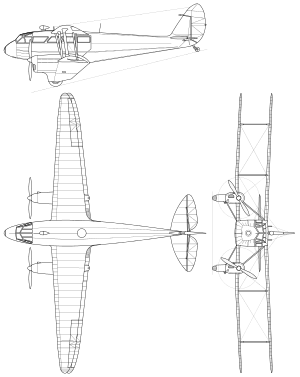
General characteristics
- Crew: 1
- Capacity: 8 passengers
- Length: 34 ft 6 in (10.5 m)
- Wingspan: 48 ft 0 in (14.6 m)
- Height: 10 ft 3 in (3.1 m)
- Wing area: 340 ft² (32 m²)
- Empty weight: 3,230 lb (1,460 kg)
- Loaded weight: 5,500 lb (2,490 kg)
- Powerplant: 2 × de Havilland Gipsy Six inline engine, 200 hp (149 kW) each
Performance
- Maximum speed: 157 mph (136 kn, 253 km/h) at 1,000 ft (305 m)
- Range: 573 mi (498 nmi, 920 km)
- Service ceiling: 16,700 ft (5,090 m)
- Rate of climb: 867 ft/min (4.3 m/s)
- Wing loading: 16 lb/ft² (79 kg/m²)
- Power/mass: 0.036 hp/lb (60 W/kg)
Notable appearances in media
A 1986 Spanish film, Dragon Rapide,[56] covers its historical use by Generalissimo Francisco Franco during the preparation for the Spanish Civil War.[57]
See also
Related development
Related lists
References
Notes
- ↑ Moss 1966, pp. 10, 12.
- 1 2 3 4 5 6 7 8 9 10 Moss 1966, p. 3.
- 1 2 3 4 5 6 7 Moss 1966, p. 4.
- 1 2 3 4 Moss 1966, p. 5.
- ↑ Moss 1966, pp. 5–6.
- 1 2 3 4 5 6 Moss 1966, p. 6.
- ↑ Moss 1966, pp. 3–4.
- ↑ Jackson, 1978, pp. 362–363.
- ↑ Moss 1966, pp. 4–5.
- ↑ Pigott 2005, p. 149.
- ↑ Alpert, Michael. BBC History Magazine, April 2002.
- 1 2 Moss 1966, pp. 6–7.
- 1 2 3 4 5 Moss 1966, p. 7.
- ↑ Moss 1966, pp. 7, 10.
- 1 2 3 Moss 1966, p. 9.
- ↑ Moss 1966, pp. 7–8.
- 1 2 3 4 5 6 Moss 1966, p. 8.
- ↑ Moss 1966, pp. 8–9.
- ↑ "Rapide Revival Flight p. 602, 30 October 1953
- ↑ "Rapide with Royal Urge", Flight: 676–677, 20 November 1953
- ↑ "Spanish Civil War Aircraft". Retrieved 2012-04-14.
- 1 2 3 4 5 6 7 8 9 10 11 "DH.89 Dragon Rapide" (PDF). Air-Britain.
- 1 2 Jackson 1973, p. 462
- ↑ "King's jockey is in missing plane". Dundee Courier (26847). 21 June 1939. p. 7 – via British Newspaper Archive. (Subscription required (help)).
- ↑ Henderson, Tony (6 November 2013). "Auction revives memory of jockey's death in County Durham plane crash". The Journal. Archived from the original on 13 November 2014.
- ↑ Jackson 1973, p. 463
- ↑ Poole 1999, pp. 120–21.
- ↑ Poole 1999, pp. 121–22.
- ↑ Jackson 1973, p. 468
- ↑ "Mersey Accident", Flight: 595, 18 November 1948
- ↑ Poole 1999, pp. 126–27.
- ↑ http://publicapps.caa.co.uk/docs/HistoricalMaterial/G-AIZI.pdf
- ↑ ASN Aircraft accident 19-FEB-1954 de Havilland DH.89A Dragon Rapide G-AFMF, accessed 8 November 2011.
- ↑ Humphreys 2001, p. 169.
- ↑ "I dag er et trist jubilæum for dansk fodbold", Politiken, 16 July 2010, accessed 9 September 2011.
- ↑ CNAPG Dragon Rapide Individual Aircraft History Page, accessed 9 September 2011.
- ↑ Abbotsford International Airshow, accessed 12 August 2018.
- ↑ "G-ADAH". airport-data.com. Retrieved 29 May 2016.
- ↑ "De Havilland 89 Dragon Rapide". fio.es. Retrieved 29 May 2016.
- ↑ Civil Aviation Authority (United Kingdom) (27 November 2016). "GINFO Search Results Summary". Retrieved 27 November 2016.
- ↑ "de Havilland DH89A Dragon Rapide 'G-AGTM'". flickr.com. Retrieved 29 May 2016.
- ↑ "Dragon Rapide Scillonia Airways" Retrieved: 16 November 2015.
- ↑ "G-AIDL". United Kingdom Civil Aviation Authority. 12 Aug 2017.
- ↑ Luke Mowatt & Peter Davison. "Dragon Rapide at Duxford". duxfordflying.co.uk. Retrieved 10 May 2016.
- ↑ "De Havilland DH 89 Dominie." National Museum of the US Air Force. Retrieved: 24 August 2015.
- ↑ "Hava Kuvvetleri Muzesi Komutanligi (Turkish Air Force Museum) – Yesilkoy – Istanbul – Turkey". aviationmuseum.eu. Retrieved 28 May 2016.
- ↑ Historic Wings Collection. Retrieved: 25 June 2016.
- ↑ dehavilland.co.za Retrieved: 25 June 2016.
- ↑ "The Fighter Factory". www.facebook.com. Retrieved 2017-09-26.
- ↑ "Paine Field museum scores rare 1930s de Havilland airplane".
- ↑ "deHavilland D.H.89 Rapide C-FAYE - CBHC". www.bushplane.com. Retrieved 2017-10-02.
- ↑ "Transportvliegtuig De Havilland DH-89A 'Dominie' registratienummer V-3 - Zoeken in de collectie - Nationaal Militair Museum". NNM. Retrieved 14 October 2017.
- ↑ "Il faut sauver le Dragon Rapide de la Ferté - Aerobuzz". aerobuzz.fr. 15 June 2017. Retrieved 29 January 2018.
- ↑ ""Museo del Aire - Madrid"
- ↑ "DH-89 "Dragon Rapide"". users.skynet.be. Retrieved 24 September 2018.
- ↑ The Janus Museum (26 October 2007). "The Captain's Paradise". Archived from the original on 16 May 2008. Retrieved 1 June 2015.
- ↑ "Dragón Rapide". IMDB. Retrieved 1 June 2015.
Bibliography
- Fresson, Ted (May 2008). Air Road to the Isles. Erskine: Kea Publishing. ISBN 978-0951895894.
- Hamlin, John F. The De Havilland Dragon Rapide Family. Tunbridge Wells, Kent, UK: Air-Britain (Historians) Ltd., 2003. ISBN 0-85130-344-7.
- Humphreys, Roy (2001). Kent Aviation, A Century of Flight. Stroud: Sutton Publishing. ISBN 0-7509-2790-9.
- Jackson, A.J. De Havilland Aircraft since 1909. Putnam & Company Ltd, 1978. ISBN 0-370-30022-X
- Jackson, A.J. British Civil Aircraft 1919–1972: Volume II. London: Putnam (Conway Maritime Press), 1988. ISBN 0-85177-813-5
- Moss, Peter W. The de Havilland Rapide: Profile Publications Number 144. Leatherhead, Surrey, UK: Profile Publications, 1966.
- Pigott, Peter. Royal transport : an inside look at the history of royal travel Toronto, Canada: Dundurn Group Publishing, 2005. ISBN 9781554882854.
- Poole, Stephen (1999). Rough Landing or Fatal Flight. Douglas: Amulree Publications. ISBN 1-901508-03-X.
External links
| Wikimedia Commons has media related to de Havilland Dragon Rapide. |
- Operators’ reference drawing ,
- de Havilland Dragon Rapide at the Military Aviation Museum